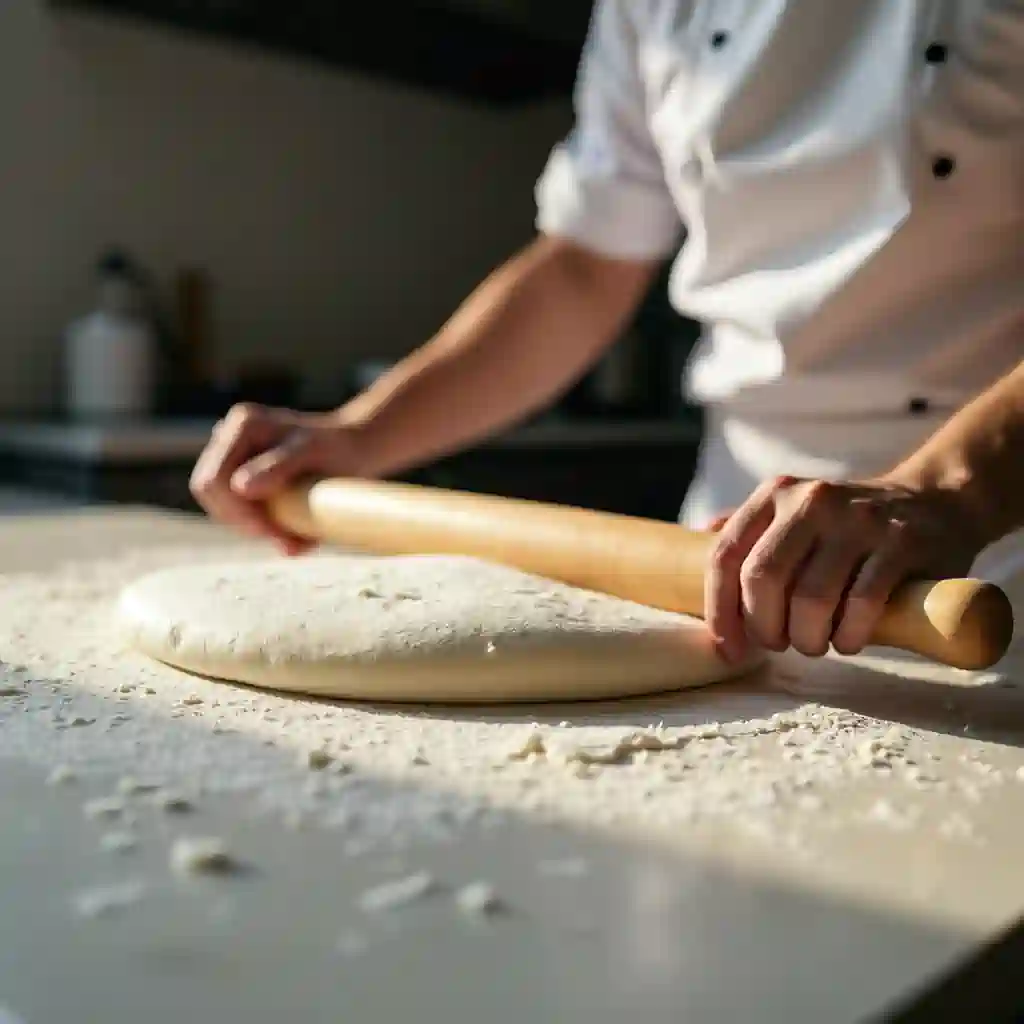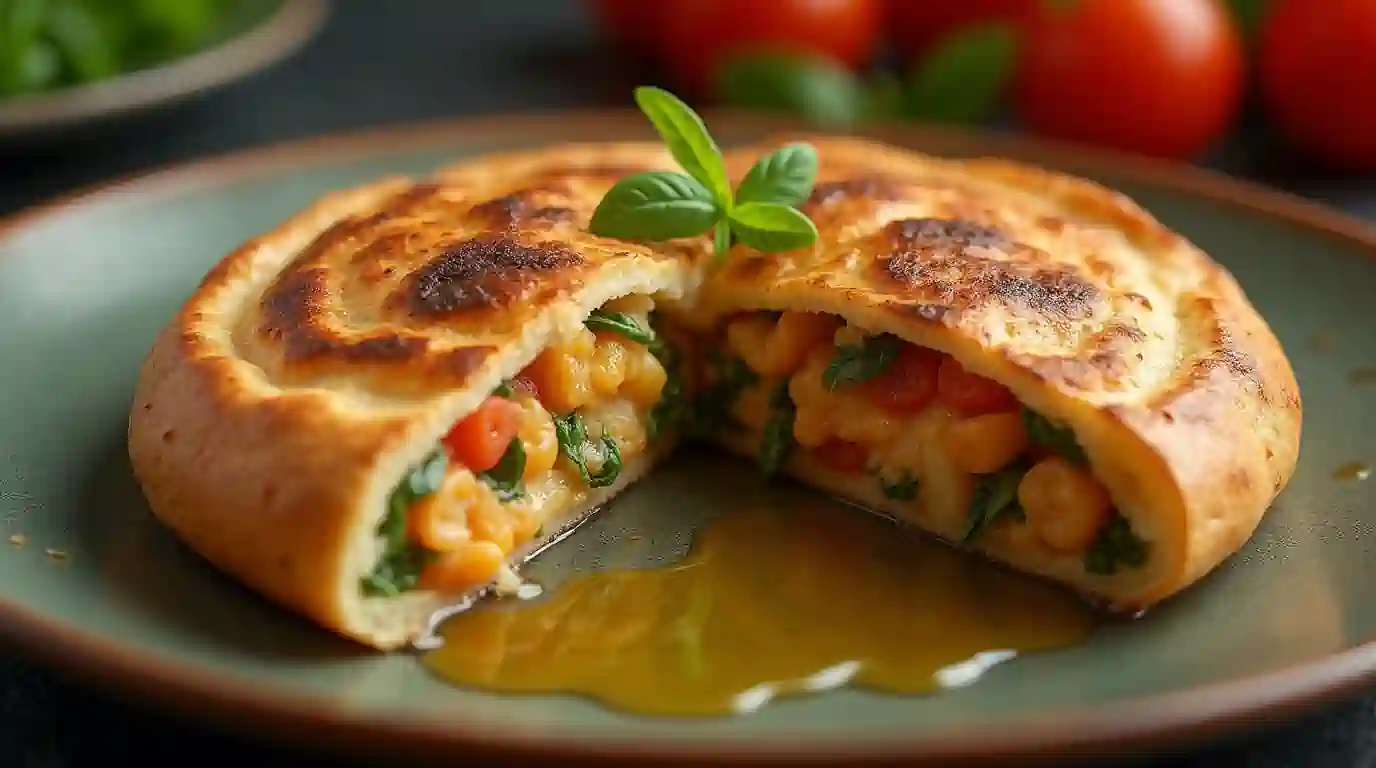Introduction to Calzone
What Is a Calzone?
A calzone is a folded, stuffed pizza that hails from Italy. It is made with simple, fresh ingredients and then baked until golden. Unlike regular pizza, a calzone is sealed, locking in all the flavors of the fillings. Typically, it is filled with cheeses, meats, and vegetables, making each bite a burst of deliciousness. Many home cooks love this dish because it is portable, hearty, and full of character. Furthermore, a well-made calzone recipe showcases the perfect balance between a crispy outer crust and a soft, savory interior.
Table of Contents
The Allure and Popularity of Calzone
Calzones have captured the hearts of food enthusiasts worldwide. Initially, this dish was a humble Italian specialty, but over time it evolved into a gourmet favorite. Today, calzones are celebrated for their versatility and convenience. Whether enjoyed as a quick lunch, a hearty dinner, or even as an appetizer, a calzone can be adapted to suit many tastes. Moreover, its unique presentation and rich, satisfying flavors have made it a trending item on social media, inspiring chefs and home cooks alike. People love to experiment with various fillings and dips, which has led to endless creative twists on the classic recipe.
Additionally, the popularity of calzones continues to grow as more restaurants and food blogs share innovative recipes and tips. In short, the calzone not only embodies Italian culinary tradition but also reflects modern creativity in the kitchen. With its appealing blend of textures and flavors, it is easy to see why this dish remains a timeless favorite among many.
“Calzone is a delicious fusion of tradition and innovation that turns every meal into a flavorful adventure.”
History and Cultural Significance of Calzone
Origins and Evolution of the Calzone
First, the calzone originated in Southern Italy as a clever way to use leftover pizza dough and ingredients. Initially, cooks folded simple fillings inside the dough, creating a portable meal. Then, as Italian cuisine spread, the calzone evolved into a dish with regional twists. Over time, traditional recipes were refined with better-quality ingredients and more creative fillings. Consequently, the calzone became a symbol of Italian culinary ingenuity. Moreover, early calzones were simple and rustic, but as chefs experimented, they introduced richer flavors and more complex ingredients. In fact, many culinary historians believe that the calzone paved the way for modern stuffed pizzas and handheld dishes.
Cultural Impact and Regional Variations
Next, the calzone has grown beyond its humble beginnings and now plays a vital role in Italian and global cuisine. Different regions in Italy have their own versions, each with unique fillings and seasoning methods. For example, some calzones feature a mix of cheeses and cured meats, while others are filled with vegetables and herbs. Additionally, as the calzone crossed borders, international variations emerged that blend local flavors with Italian traditions. Today, you can find calzones in trendy pizzerias, food trucks, and home kitchens alike. Furthermore, its versatility makes it perfect for lunch, dinner, or even a quick snack.
“From a humble Italian origin to a global culinary icon, every calzone tells a story of flavor and tradition.”
In short, the calzone’s rich history and regional diversity have cemented its status as a beloved dish. Its evolution mirrors the dynamic nature of food culture, where traditional recipes are continuously reimagined with modern flair. For more Italien recipes, check out our recipe article Ricotta
Essential Ingredients and Tools for Calzone
Key Ingredients for a Classic Calzone
First, a great calzone begins with a quality dough. Typically, the dough is made from wheat flour, water, yeast, salt, and olive oil—similar to pizza dough. Next, choose a filling that complements the dough; common options include ricotta, mozzarella, and Parmesan cheeses, along with ingredients like ham, salami, spinach, and roasted vegetables. Additionally, a simple tomato sauce or even a garlic-infused olive oil can enhance the flavor. Moreover, using fresh herbs such as basil or oregano adds a burst of color and aroma. In short, every ingredient in your calzone should be chosen to balance flavor and texture perfectly.
“Quality ingredients are the building blocks for a calzone that is both authentic and innovative.”
Must-Have Kitchen Tools and Equipment
Now, to create your perfect calzone, you also need the right tools. First, a large mixing bowl is essential for preparing the dough. Then, accurate measuring cups and spoons ensure the ingredients are added in the proper proportions. Additionally, a rolling pin is vital for evenly flattening the dough before adding your fillings. Next, a sharp knife or pizza cutter will help you trim and shape the calzone. Moreover, a baking stone or heavy baking sheet is ideal for achieving a crisp, golden crust. Finally, if you have a pizza peel, it can assist in transferring your calzone into the oven safely.
“The right equipment not only makes the process smoother but also ensures your calzone turns out perfect every time.”
In summary, with quality ingredients and proper tools, your calzone will be set for success. For more detailed kitchen tips and related recipes, check out our recipe article Turkey Meatloaf Recipe
Step-by-Step Preparation and Assembly
Preparing the Dough and Filling

First, start by preparing the dough for your calzone. In a large bowl, combine water, yeast, and a pinch of sugar; let it sit until it becomes frothy. Next, mix in all-purpose flour, salt, and olive oil. Stir the ingredients together until a rough dough forms, and then knead it on a lightly floured surface until it becomes smooth and elastic. This process should take about 10 minutes. As you work the dough, remember that a well-kneaded dough is key to a perfectly soft yet sturdy calzone.
Meanwhile, prepare the filling. Start by gathering your favorite ingredients, such as a blend of ricotta, mozzarella, and Parmesan cheeses. Next, chop vegetables like spinach, mushrooms, or bell peppers into small pieces. In a separate bowl, mix the cheeses with the vegetables and add seasonings such as salt, pepper, and a sprinkle of dried basil. If you like, you can also add sliced cured meats like pepperoni or ham to enhance the flavor. The key is to keep the filling balanced so that every bite of your calzone is both savory and rich. Additionally, if you prefer a touch of sauce, you can stir in a small amount of marinara or tomato sauce to the mixture.
After preparing both the dough and the filling, cover the dough with a damp cloth and let it rest for about 1 hour or until it doubles in size. Resting not only allows the yeast to work its magic but also makes the dough easier to roll out later.
Assembly, Baking, and Finishing Techniques

Now, roll out your dough on a clean, lightly floured surface. Aim for an even, circular shape that is about 1/4 inch thick. Next, spoon the filling onto one half of the dough, leaving an edge of about 1 inch. Be careful not to overfill, as this can cause the calzone to burst during baking. Once the filling is in place, fold the dough over carefully to create a semi-circle, then press the edges together firmly. To ensure a good seal, you can crimp the edges with a fork or pinch them by hand.
After assembling your calzone, transfer it to a lightly greased baking sheet or pizza stone. Preheat your oven to 425°F (220°C). Before baking, you might want to brush the top of the calzone with olive oil for a golden, crispy finish. Then, place it in the oven and bake for 15 to 20 minutes, or until the crust turns a deep golden brown and the filling is heated through.
While the calzone bakes, keep an eye on it so that it does not overcook. Once done, remove it from the oven and let it rest for 5 minutes. Resting allows the flavors to settle and the filling to thicken slightly, making the calzone easier to cut. Finally, slice your calzone into wedges and serve it warm with a side of marinara or your favorite dipping sauce.
For more delicious recipes, check out our recipe article BBQ Meatloaf Recipe
Variations and Creative Twists for Calzone
Flavor Variations and Alternative Fillings
First, once you have mastered the basic calzone, you can experiment with a variety of creative twists. For example, try swapping out traditional cheeses for a blend of goat cheese and mozzarella to create a tangy flavor profile. Next, consider incorporating different vegetables such as artichokes, sun-dried tomatoes, or even roasted red peppers to add extra depth and color. Moreover, if you enjoy meat, adding spicy Italian sausage or crumbled pepperoni can offer a bold twist. Alternatively, for a vegetarian option, combine a medley of spinach, ricotta, and pine nuts for a fresh, delightful filling. These substitutions allow you to tailor your calzone to your taste while still keeping its classic charm.
“A creative twist can transform your calzone into a unique culinary masterpiece.”
Tips for Serving and Presentation
Now, presentation matters just as much as taste. First, when serving your calzone, slice it into generous wedges that reveal the delicious interior. Then, consider garnishing each plate with a sprinkle of fresh basil or a light drizzle of extra virgin olive oil to enhance the flavor. Additionally, pairing the calzone with a side of zesty marinara or a fresh green salad can balance the richness of the filling. Furthermore, if you plan to serve it at a gathering, you might cut the calzone into smaller, bite-sized pieces for easy sharing. Finally, use a rustic platter to evoke an authentic Italian feel and to make your dish look inviting and appetizing.
Conclusion and Final Thoughts
Recap of Key Points and Benefits
This guide has covered everything you need to make a perfect calzone. We explored its Italian origins, essential ingredients, and key techniques for achieving a crispy crust and flavorful filling. Step-by-step instructions highlighted the importance of each stage, from dough preparation to baking. Additionally, we shared creative variations and expert tips to personalize your calzone. Making your own allows you to enjoy authentic Italian flavors while crafting a dish perfect for any meal.
Final Tips and Encouragement for Home Cooks
Furthermore, always remember that practice makes perfect. Start by following the recipe closely, and then feel free to experiment with different fillings and sauces. For example, try using fresh herbs or a dash of extra spice to add your own signature twist to your calzone. Also, keep your work area organized and your ingredients fresh, as these details make a big difference. Additionally, don’t hesitate to ask for advice or share your successes with fellow home cooks. Each attempt is a step towards mastering your own version of a calzone that is both delicious and unique.
“Every new recipe is a step forward on your culinary journey, and every calzone you make brings you closer to perfection.”
Happy cooking, and enjoy every flavorful bite of your homemade calzone!
recipes and tips: You’ll need plenty of sauce to try
- Hello Fresh Meatloaf Recipe: Made Simple with a Gourmet Twist
- Cinnamon Rolls: The Ultimate Guide to Perfect Homemade Treats
- How Long Does A 2lb Meatloaf Take At 350 Degrees? Simple Cooking Tips
- What Is The Basic Meatloaf Formula? Simple Ingredients, Perfect Results
- What Does Adding An Extra Egg To Meatloaf Do? A Simple Recipe Hack

